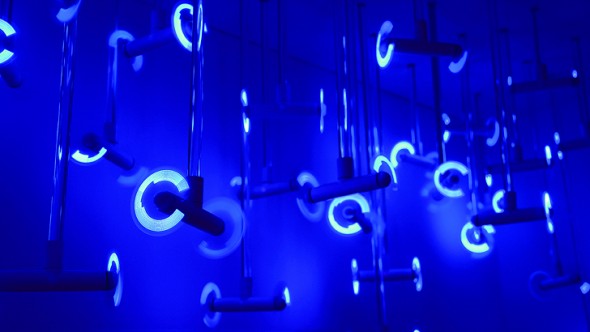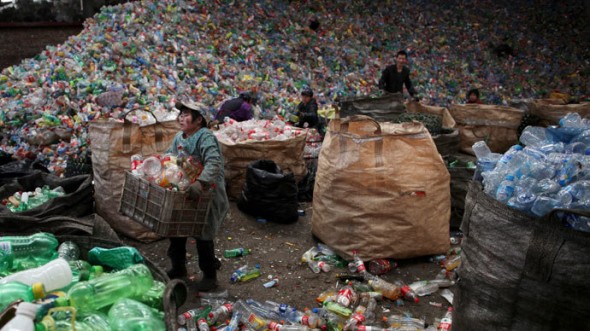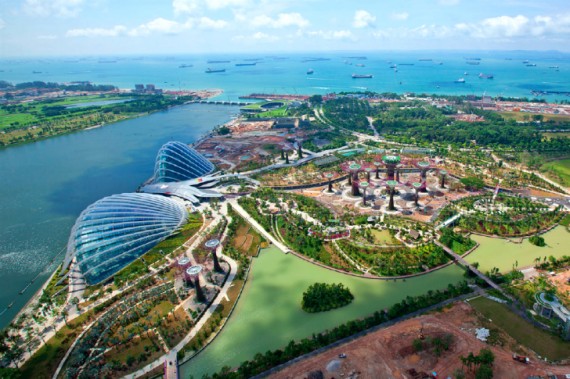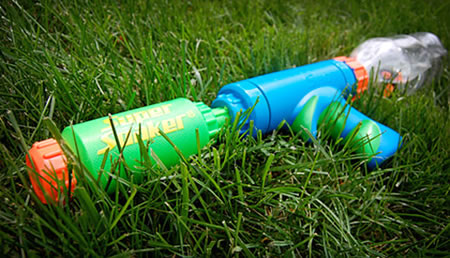
The Super Soaker is the ultimate weapon in water warfare; after all there is no better way to beat the immense heat this summer than annihilating your lawn intruders. The only downside is that like with all water guns you eventually have to refill it, which can leave you vulnerable to soakings from the enemy. But instead of coming with a water reservoir tank, the Super Soaker Bottle Shot allows you to screw on a standard plastic bottle instead. In fact it can even accommodate a 2 liter pop bottle allowing you to reuse them as back up liquid ammunition for when you’re in the heat of battle. The downside is that the Super Soaker Bottle Shot only works on a pump by pump basis. So every time you pump the handle, it fires a 20 foot stream of water.

Some of us are fans of water therapy; we spend a lot of our time taking a shower without thinking twice about water conservation. Aperture Showerhead is a new showerhead to make you feel a little more guilty the next time you step into the shower, it works by displaying the volume of water consumed while you’re showering, this way you’ll notice your water consumption and help to save it by setting your water consumption limit. It is ergonomically designed to concentrate the water flow on the body without room for wastage.
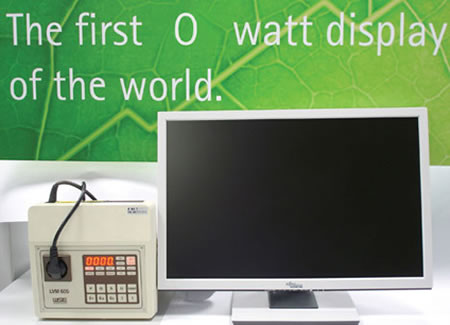
Very few companies take a green initiative while producing new products that help the environment. Fujitsu Siemens has developed a new monitor that claims to use zero power in standby mode. This money-saving monitor miracle is made possible thanks to a built-in switch that shuts down the monitor completely when a signal from the computer is absent—and then abruptly brings it back to life when the signal reappears. This sort of technology will prove especially useful for businesses, which is why Fujitsu is aiming squarely at this market when the monitor is released this summer.
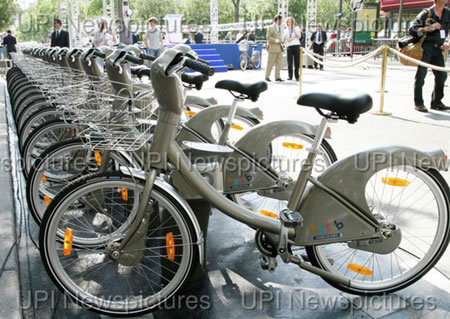
After Paris it’s now time for Washington to have its own bike sharing program. A new bike-sharing venture in Washington called SmartBike DC will allow people to rent bicycles using only a membership card, Washington Transportation Department official Jim Sebastian said the new public venture will have 10 locations throughout the district and will have 120 bicycles available for rent, The New York Times reported Sunday. The automated rental program comes thanks to a deal with advertiser Clear Channel Outdoor, which will have advertising rights to all district bus shelters. Sebastian told the Times if the program enjoys similar success as other plans in Paris and Barcelona, the number of available bikes could one day reach 1,000.

Britain’s armed forces are planning to end the military dependency on fossil fuels. Possible innovations include unmanned attack aircraft powered by the sun. They would fire missiles fuelled with hydrogen produced by feeding algae to microbes. Tanks could be electrically powered or run on fuel produced from oil squeezed out of weeds so hardy they can grow in the desert. Ships could run completely on electricity produced from generators powered by synthetic fuels made from grass. The environmental requirements of the army, navy and air force will be presented this week to specially vetted defence and research companies. The Ministry of Defence (MoD) said last week that many of the ideas would come to fruition only in the next generation. The US Air Force, however, is expected to start converting its aircraft to use a mix of synthetic and petroleum-based fuel by the end of 2010 and the RAF is likely to follow suit. The Royal Navy’s new Type45 destroyers already use all-electric propulsion, albeit produced by gas generators, and greener ways of producing the electricity are being explored in conjunction with the French. Turning all three services “green” was one of a number of new defence targets outlined last week by Paul Stein, the MoD’s science and technology director, to the Royal Aeronautical Society in London. Others included more unmanned, missile-carrying aircraft; lightweight tanks; ultra-light equipment for soldiers and futuristic communications devices. While some of the plan will be made public, most will be made available on a secure website to selected company and university research departments. “It will provide clear direction to the research and development community,” the ministry said.

Brazil has been the world’s largest producer of ethanol from sugar cane for nearly three decades and the country has more than 30,000 filling stations that market the biofuel. U.S. Company Amyris Biotechnologies and Brazilian sugar and ethanol group Crystalsev have formed a joint venture to produce and sell the first commercial diesel made from sugar cane instead of oilseeds like soy and canola. In sugar cane, Melo said, “Brazil has the most sustainable and economic raw material,” adding the new diesel will be competitive as long as crude oil remains above $60 a barrel. The first commercial production unit will be built in partnership with one of Brazil’s most advanced sugar and ethanol mills, Santa Elisa — owned by Crystalsev’s major shareholder, Santelisa Vale — in Sao Paulo state. The mill will supply 2 million tonnes of cane a year to the plant, which is expected to come on-line in 2010 and produce 10 million gallons of biodiesel in the first year of operation. Total production within the first five years of operation is expected to reach 1 billion gallons, including the first plant and other units to be built. Amyris is negotiating with Brazil’s National Petroleum Agency to get permission to market the new product. Brazil launched in January a biodiesel program that now mandates a 2 percent blend in all retail diesel. The blend will rise to 3 percent on July 1 and to 5 percent by 2013. Brazil is the world’s largest cane ethanol producer and is forecast to harvest a record cane crop of about 550 million tonnes this season.
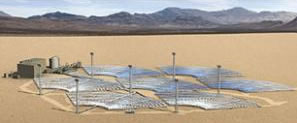 Soon setting up a solar power station is to get a lot more user friendly and a new technology could change the solar industry. IKEA changed the rules for furnishing a home. The eSolar power plant is based on mass manufactured components, and designed for rapid construction, uniform modularity, and unlimited scalability. Each eSolar module, though, is designed to generate 33MW of power — enough juice to power 10,000 homes. If you need 330MW, you just buy ten modules and put them together. It’s not exactly flat-pack home furnishings, but it’s the same world-changing idea. Presumably, you’ll need more tools than those little Allen wrenches and nifty fasteners IKEA supplies with its furniture. However, you don’t need the heavy equipment, cranes and trained engineers now required to put traditional thermal power plants together: eSolar has replaced expensive steel, concrete, and brute force with inexpensive computing power and elegant algorithms. This new method of installing a solar power plant minimizes costly civil construction and the use of heavy equipment, dramatically reducing project cost and deployment time. That’s a big claim when you consider that a 33MW modular plant needs 160 acres of land — about 1/4 of a square mile. It’s still a job for a trained construction crew that knows what to do when they open the eSolar box. Inside are many identical towers and thousands of small mirrors — each about a meter square in size — engineered back in eSolar’s manufacturing plant — to essentially snap together. At least that’s how it seems after talking to eSolar executives, who are playing the details very close to the chest. They’re promising to show off a portion of a module at a demonstration facility somewhere in Southern California before the end of this year. eSolar says solar energy that is cheaper than coal is the goal. The company isn’t yet ready to divulge the cost of a module, but claims that right now, its solution is competitive with natural gas, which can produce electricity for 9 cents a kilowatt-hour. Between the rising price of both gas and construction,
Soon setting up a solar power station is to get a lot more user friendly and a new technology could change the solar industry. IKEA changed the rules for furnishing a home. The eSolar power plant is based on mass manufactured components, and designed for rapid construction, uniform modularity, and unlimited scalability. Each eSolar module, though, is designed to generate 33MW of power — enough juice to power 10,000 homes. If you need 330MW, you just buy ten modules and put them together. It’s not exactly flat-pack home furnishings, but it’s the same world-changing idea. Presumably, you’ll need more tools than those little Allen wrenches and nifty fasteners IKEA supplies with its furniture. However, you don’t need the heavy equipment, cranes and trained engineers now required to put traditional thermal power plants together: eSolar has replaced expensive steel, concrete, and brute force with inexpensive computing power and elegant algorithms. This new method of installing a solar power plant minimizes costly civil construction and the use of heavy equipment, dramatically reducing project cost and deployment time. That’s a big claim when you consider that a 33MW modular plant needs 160 acres of land — about 1/4 of a square mile. It’s still a job for a trained construction crew that knows what to do when they open the eSolar box. Inside are many identical towers and thousands of small mirrors — each about a meter square in size — engineered back in eSolar’s manufacturing plant — to essentially snap together. At least that’s how it seems after talking to eSolar executives, who are playing the details very close to the chest. They’re promising to show off a portion of a module at a demonstration facility somewhere in Southern California before the end of this year. eSolar says solar energy that is cheaper than coal is the goal. The company isn’t yet ready to divulge the cost of a module, but claims that right now, its solution is competitive with natural gas, which can produce electricity for 9 cents a kilowatt-hour. Between the rising price of both gas and construction,



